William H. Gass is a professor of philosophy
and lived part of his life in Indiana. He was born on July
30, 1924, in Fargo, North Dakota, and soon moved to Warren,
Ohio, where he grew up. He began his education at Kenyon College
in Gambier, Ohio. Gass received his bachelor's degree in Philosophy
in 1947, after serving in the Navy during World War II. He
received his Ph.D. from Cornell University in 1954. He then
moved to Indiana and taught at Purdue University in West
Lafayette, Indiana, for fifteen years. Gass is currently
teaching Philosophy and English at Washington University in
St. Louis, Missouri. Gass's first novel, Omensetter's
Luck, was published in 1966 while he was still teaching
at Purdue. This novel focused on life in small-town Ohio,
and was influenced by his time growing up in Warren.
Two years later, In
the Heart of the Heart of the Country and Other Short Stories
was published. This book is a collection of five short stories,
all of which revolve around the themes of loneliness, isolation,
and lost love.
The short story entitled "In the Heart of
the Heart of the Country" takes place in a fictional
rural town called "B," Indiana. The narrator, obviously
depressed and suffering from loneliness and heartache, describes
in great detail the people, scenery, and life in B. The town
is fictional, but it is modeled after Gass’s experience
with several towns near his home in Indiana.
The narrator tells about the landscape around
him. He complains of the usual heat and humidity of an Indiana
summer and describes the Wabash River
in a drought. In general the atmosphere of the story is reflected
in a grimy, bland environment: "[T]he sky in the winter
is heavy and close, and it is a rare day...when the sky lifts
and lets the heart up" (173).
Even when it snows, nothing improves: “[I]t
is snow without any laughter in it.... [O]f course soot covers
everything" (192). He mentions that automobile exhaust
and litter pollute the streets, and he says the "brick
could be beautiful but we cover it with gray industrial vomits"
(193). It is apparent that this small town is not out of reach
from the air
pollution resulting from industrialization. He expresses
his disgust of the overpopulated cities, saying that
“man has never been a fit environment for man"
(193).
 |
Disregard
for the land causes trash to accumulate |
The narrator describes a row of maples near his
house, which have had their tops cut off to avoid interference
with electric wires. "These wires offend me. Three trees
were maimed on their account, and now these wires deface the
sky" (174). He is upset that people must destroy the
beauty of natural things for civilization’s material
needs. In another example of his disillusionment with Indiana's
environment, he characterizes his neighbors as having total
disregard for the land: “They will collect piles of
possibly useful junk in their yard…give not a hoot for
the land…” (182). The town is poor, and "nearby
cities have siphoned off all but a neighborhood trade"
(189).
Not everything is gloomy. He describes a beautiful
fall day full of color. He wonders why anyone would want to
live anywhere else. "And it is surely better to live
in the country, to live on a prairie
by a drawing of rivers...in
Indiana, say, than in any city”(192). The narrator feels
that although small-town Indiana has its downfalls, it is
better than dealing with the more extensive urban
sprawl
and pollution
found in cities. He then points out, however, that the farmers
in the country use their chemicals and machines for agriculture,
which is also a form of pollution.
Gass is referring to a fictional town in this
short story, but at the same time he is referring to all towns
in Indiana. For the most part, he presents a pessimistic,
depressing view of Indiana's environment. Although these descriptions
are accurate to a degree, Gass also expresses an appreciation
for Indiana's rural landscapes.
--KMS
Sources:
Gass, William H. Dept. of English
Home Page. Cornell University. 5 Nov.2002 <http://www.arts.cornell.edu/writers/gass.html>.
---.In the Heart of the Heart
of the Country and Other Stories. New York: Harper and
Row, 1968.
Hix, H.L. Understanding William
H. Gass. Columbia: UP of South Carolina, 2002.
McCaffery, Larry. The Metafictional
Muse. Pittsburgh: UP of Pittsburgh, 1982.
Saltzman, Arthur. The Fiction
of William Gass: The Consolation of Language. Carbondale:
Southern Illinois UP, 1986.
"William H. Gass." Washington
University in St. Louis.. 30 Sept. 2002 <http://www.artsci.wustl.edu/~philos/history/narrative/gass.html>.
Images:
Ravid, Joyce. "William H. Gass."
Archives, Cornell University. 5 Nov.2002 <http://www.arts.cornell.edu/writers/gass.html>.
Copyright (c) Joyce Ravid.
Smith, Dean. "Disregard for the
Land." Personal photograph by the author. 30 Sept. 2002.
Links:
Interview
with Pif Magazine
Complete Bibliography
on New York Review of Books
St.
Louis Walk of Fame
1979
Commencement Speech at Washington University
|




